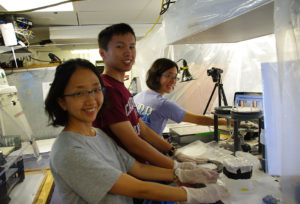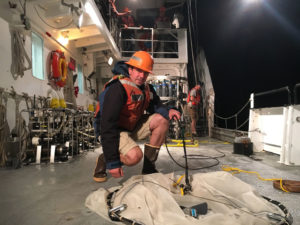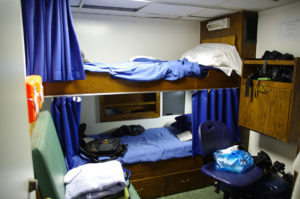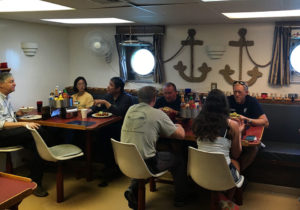The following are some observations about research life on a boat, in no particular order.

Jong-Mi Lee, Yang Xiang and Phoebe Lam of UC Santa Cruz process samples in their “Bubble” on board the Oceanus.
Lab on a Ship
Setting up and organizing the various lab spaces take up a large proportion of the time spent loading a ship. Phoebe Lam’s “Bubble” and Jim Bishop’s clean air-water filtration station are examples of spaces that the researchers need to ensure that the samples they collect are not contaminated.
When the researchers are not out on deck deploying or recovering equipment, they are often found in the main lab area working with the samples or the robotic floats.
Seasickness
This trip has been mercifully smooth, with light winds and low to moderate swells of 4- to 8-feet high. The stories told by the seasoned veterans on this trip indicate that we are lucky.
“I’ve had to strap myself to my chair before,” said Todd Wood, Berkeley Lab engineer.
The good news is that you don’t have to be immune from seasickness to be a rock-solid marine scientist. Ask Phoebe Lam of UC Santa Cruz. She has logged more than a year at sea on research vessels, and she readily admits to being highly susceptible to motion sickness.
“I believe in the power of chemistry,” said Lam, who found a cocktail of medications prescribed by her doctor to quell her nausea without knocking her out. She battles this because the science repeatedly draws her back to the sea.
Work Hours

Mike Stukel of Florida State University prepares his gear for an evening “plankton tow.” (Photo: Sarah Yang)
The crew members work in four-hour shifts, with eight hours off, so that the scientists are supported around the clock. The scientists have no set hours. Today (Saturday), the ship arrived around 3:30 a.m. at its second station, a spot about 350 miles off the California coast. Within 15 minutes of its arrival, we launched a CTD.
Wi-Fi
I had high hopes that I’d be able to post slideshows and videos during the trip. I got a reality check during the ship’s orientation, when we were told that as soon as the ship left the dock, we’d be put on a strict data diet of 200 megabytes per day, which is relatively generous by boat standards. Some research cruises allow only 50 megabytes per day, and others don’t have wi-fi at all.
Nevertheless, I managed to exceed my data limit three days in a row, and I was not alone. Were it not for the generosity of others on the boat who shared their data allotment with me in a pinch, I would not have been able to post updates during the trip.
Safety
During deployments, the deck is an active work site. A quick way to get the crew upset is to try to walk under a loaded boom without wearing a hard hat. Just. Don’t. Do. It. Life jackets are also required when working out on deck.
Life jackets and helmets are stored in the wet lab of the ship, conveniently located en route to the deck.
It’s also important to let people know when we want to walk out on deck alone. If it’s at night, we’re asked to wear a life vest and bring someone with us in case one of us goes overboard.
Close Quarters
The living quarters are below deck, except for the captain’s room, which is up near the bridge. Everyone on the research team shares a cabin with one other roommate, and multiple cabins share a shower and bathroom.
Water, Showers and Laundry
While the supply of water is not endless, it is generous. The boat’s flash evaporator is capable of producing 2,400 gallons of distilled water a day, far more than what is consumed by the 25 people on board this trip. Heat is used to boil seawater under vacuum, and the vapor is condensed and collected for our use. When the ship is on the move, the engineers switch to the heat from the engine to generate the freshwater we use. The waste heat from the engine can bring water up to 160 degrees Fahrenheit, so separate heating is not necessary.
We have been given no restrictions on showers, an odd feeling for those of us used to conserving water because of the drought in California. As for washers and dryers, the crew and science team alternate days of access to the laundry room.
Food
There is a cook and a steward on board who whip up three hearty meals a day for the people on the boat. The meals are served on a regular schedule (7:15 a.m., 11:15 a.m., and 5:15 p.m.), but people can help themselves to leftovers if their shift keeps them from sitting down to dine at those times. A big draw is the chest freezer in the pantry that has ice cream, which we’re allowed to access when the need arises. And that need arises often.
Exercise
There is no running on deck, but the crew managed to tuck away a folding treadmill in the winch room below deck. The room gets hot when the machinery is running, which is often, so the conditions facilitate a good sweat. It’s a tight fit, especially if you’re tall, but a few people have managed to get in a workout or two.
“Just keeping your balance and standing up while the boat is rocking is great exercise,” noted Jim Bishop.
Downtime
There’s a lounge with a 42-inch satellite TV, and a decent collection of DVDs. The bookshelves include a wide range of reading material, from
the Encyclopedia of Ocean Science to Charles Dickens novels to Sports Illustrated magazine.
The room is rarely full since most of the people on the ship are busy with other tasks, but it’s a great place to hang out during short breaks.
###
Be sure to return to this site once the voyage ends (and more bandwidth is available) for more photos — and videos — from the research effort.



